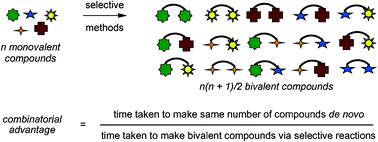Heterovalent selectivity and the combinatorial advantage
Abstract
Libraries of monovalent compounds can be reacted with each other to give libraries of bivalent ones. If those reactions are efficient, and if the products do not need to be purified, large numbers of bivalent compounds can be produced rapidly, and one might say there is a “combinatorial advantage” to doing so. However, selective formation of heterobivalent products must be possible otherwise statistical mixtures will form. This tutorial review describes methods that will give heterobivalent compounds almost exclusively. Although there are relatively few methods that will give that desired selectivity, such methods are becoming increasingly important as the potential applications of bi- and multivalent compounds emerge.


 Please wait while we load your content...
Please wait while we load your content...